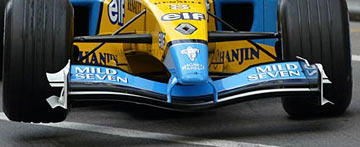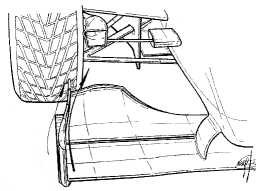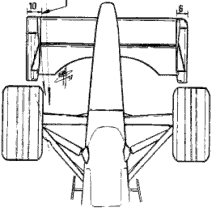Front wing aerodynamics
The front wing of a Formula One car creates about 25% of the total cars downforce. Although this only occurs in ideal circumstances. When a preceding car runs less than 20m in front, the total downforce generated by the front wing may become as little as 30% of its normal downforce. Although this reduce of drag (because the air pressure is lower behind a car's rear wing), enables higher speeds at the end of straight, it significantly hinders the pursuing car in corners, as he cannot take these at normal speeds. This problem mostly occurs in fast corners, and is one of the most important reasons of the overtaking problem currently in Formula One. It is therefore a hard job to create a performing front wing, even more because disturbing the airflow too much will affect the rest of the car's aerodynamic efficiency too.
Regulations
3.4 Width ahead of the rear wheel centre line :
3.4.1 Bodywork width ahead of the rear wheel centre line must not exceed 1400mm.
3.4.2 In order to prevent tyre damage to other cars, the top and forward edges of the lateral extremities of any bodywork forward of the front wheels must be at least 10mm thick with a radius of at least 5mm.
3.7 Front bodywork height:
All bodywork situated forward of a point lying 330mm behind the front wheel centre line, and more than 250mm from the centre line of the car, must be no less than 100mm and no more than 300mm above the reference plane.
3.17.1 Bodywork may deflect no more than 5mm vertically when a 500N load is applied vertically to it 700mm forward of the front wheel centre line and 625mm from the car centre line. The load will be applied in a downward direction using a 50mm diameter ram and an adapter 300mm long and 150mm wide. Teams must supply the latter when such a test is deemed necessary.
Front wing design
A regular front aerofoil is made as a main plane running the whole width of the car (almost at least, limited by FIA regulations) suspended from the nose. Onto this are fitted one or more flaps which are the adjustable parts of the wing. On each end of the mainplane there are endplates. These make sure the airflow passes above and beneath the wing rather than around it. In recent years these endplates have played a crucial role in influencing the airflow around the front tyres, especially after the rule changes at the beginning of 1998 (wheelbase made smaller from 220cm to 180cm). These changes made front wing airflow interfere with the rotating airflow around the front wheels.
Article 3.17 has been introduced during 1998, after teams started experimenting with bending front and rear wings. When Ferrari introduced such a front wing at the end of 1997, it was produced in such a way that the wing would flex under aerodynamic loads. This means that as the speed increased, a force was produced that pushed the wing towards the ground. By means of a ground effect, this was particularly interesting for front wings because if would increase downforce at high speeds without an increase of drag. As rear wings began to fail and flew off during races, the FIA thought it was time to act and added 3.17 to the technical regulations of Formula One.
 At the beginning of 2001, front wing regulations had changed in such a way, that the wing should be 100mm above the ground at least, instead of the 40mm until then. The FIA introduced this change to limit the cornering speeds of the cars. The idea was to decrease the ground effect that was generated by front wings close to the ground, working just like a diffuser.
At the beginning of 2001, front wing regulations had changed in such a way, that the wing should be 100mm above the ground at least, instead of the 40mm until then. The FIA introduced this change to limit the cornering speeds of the cars. The idea was to decrease the ground effect that was generated by front wings close to the ground, working just like a diffuser.
Immediately at the start of the season, Ferrari introduced a front wing that was bent down in the center line or the car. This new concept makes a handy use of a little hole in the regulations. The whole is the result of a rule, added in 1994, where the wooden bottom made it's entry. This wooden plate can be hung up as low as possible to the ground. As this plate is 50 cm wide, it was not foreseen that the front wing may be placed that low to the ground in 25cm at each side of the center of the car. Since the introduction by Ferrari, more and more teams have adopted the idea of curved front wings, with them also McLaren and Renault (see picture).
Though the reason that McLaren didn't make any of those changes until 2002, might have to do with the curve of the front wing before the change of regulations. It was namely curved up in the middle, so that the inner side was higher above the ground then both outer sides of the front wing. This type of wing is mostly useful on fast tracks where not much downforce is needed. It is there that airflow in the centre of the car can be more used by the diffuser in the back instead of lifting it up and create downforce in the front.
End plates

 As some of the air that is needed to generate the front wing's downforce interferes with the rotating air around the front wheels, F1 teams have been developing the end plates from a simple plate to an integral part of the wing. To overcome the main problem of turbulence around the wheel, McLaren, and later Ferrari made in 1998 the inside edges of the front wing endplates curved to direct the air between both front wheels. One year after, all teams had adopted this technique to maintain front wing efficiency. Some other teams decided to decrease the width of the main plane just to the width between the front wheels. This left some room for extra wings and flaps, which caused the beginning of intensive end plate research. In 1998 changes were so radical that Ferrari produced six different designs of front wings throughout 1999, in order to reclaim the lost downforce by regulation changes.
As some of the air that is needed to generate the front wing's downforce interferes with the rotating air around the front wheels, F1 teams have been developing the end plates from a simple plate to an integral part of the wing. To overcome the main problem of turbulence around the wheel, McLaren, and later Ferrari made in 1998 the inside edges of the front wing endplates curved to direct the air between both front wheels. One year after, all teams had adopted this technique to maintain front wing efficiency. Some other teams decided to decrease the width of the main plane just to the width between the front wheels. This left some room for extra wings and flaps, which caused the beginning of intensive end plate research. In 1998 changes were so radical that Ferrari produced six different designs of front wings throughout 1999, in order to reclaim the lost downforce by regulation changes.
